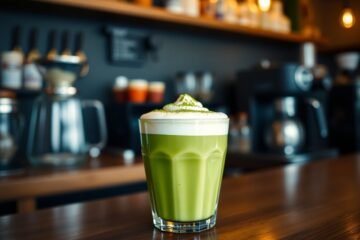With a growing interest in healthier alternatives to your daily coffee, matcha lattes have emerged as a popular choice among enthusiasts. This vibrant green tea powder not only delivers a unique flavor but also offers a rich array of antioxidants and energy-boosting properties without the crash often associated with coffee. In this blog post, you’ll discover crucial tips on how to craft the perfect matcha latte, along with some surprising benefits that make it a worthy addition to your beverage repertoire. Your coffee routine is about to get a delightful upgrade!
Key Takeaways:
- Matcha latte offers a unique flavor profile that blends the earthy notes of green tea with creamy textures, providing a delightful alternative to traditional coffee drinks.
- Rich in antioxidants and L-theanine, matcha can enhance focus and reduce jitters, making it an ideal beverage for those looking to balance energy with calm mental clarity.
- Experimenting with different milk types, sweeteners, and ratios can lead to personalized matcha latte recipes, allowing coffee lovers to discover new and satisfying variations.
The Unique Flavor Profile of Matcha
Matcha presents a truly unique flavor profile that differentiates it from standard teas and coffees. The blend of earthy notes, subtle sweetness, and a hint of bitterness creates a complex experience in every sip. The vibrant green color is not only visually appealing but also indicates the high levels of chlorophyll and nutrients present. You’ll find that the creamy texture of a matcha latte balances these flavors harmoniously, making it a refreshing alternative that coffee lovers can appreciate.
From Bitter to Sweet: Understanding Matcha’s Complexity
Delving into matcha’s complexity reveals layers of flavor ranging from bitter to sweet, often influenced by its particular variety and preparation method. Higher-quality matcha tends to have less bitterness due to the shading process before harvest, which boosts its natural sweetness. You may notice that with each sip, the tastes evolve, enhancing your experience and making matcha a delightful adventure for your palate.
How Matcha Compares to Traditional Coffee
While coffee is celebrated for its boldness and intensity, matcha provides a gentler, but equally stimulating alternative. In terms of caffeine content, matcha offers a steadier and less jittery energy lift compared to traditional coffee. One cup of matcha latte can contain roughly 70 mg of caffeine, while an average cup of brewed coffee can contain between 95 to 200 mg. This unique balance allows you to enjoy sustained energy without the crash often associated with coffee consumption.
Comparative Analysis: Matcha vs. Coffee
| Aspect | Matcha |
|---|---|
| Caffeine Content | About 70 mg per cup |
| Taste Profile | Earthy, slightly sweet, creamy |
| Health Benefits | Rich in antioxidants, boosts metabolism |
| Energy Level | Sustained, without jitters |
| Preparation Time | Quick, whisking required |
Matcha’s preparation involves whisking the powdered form with hot water or milk, offering a unique ritual that contrasts sharply with the straightforward brew of coffee. This experience can be engaging and enriching, inviting mindfulness into your daily routine. Plus, the presence of the amino acid L-theanine found in matcha assists in promoting focus, providing a calm yet alert state, which coffee cannot replicate in the same way. Transitioning to matcha from coffee could unveil an enjoyable new experience that revitalizes your beverage choices.
Health Benefits That Will Make You Rethink Your Brew
Switching to a matcha latte not only diversifies your drink repertoire but also offers profound health benefits that might surprise you. Loaded with nutrients, this vibrant green beverage can enhance your overall well-being with its unique properties. If you’re intrigued and eager for more matcha recommendations and pairings needed, check out this link.
Antioxidants Galore: What Matcha Brings to the Table
Matcha is rich in catechins, a class of antioxidants that outshine those found in regular green tea. By sipping on matcha, you’re ingesting up to 137 times more antioxidants than in standard green tea, which can help combat free radicals in your body. This means your cells are better protected, reducing inflammation and potentially lowering the risk of chronic diseases.
The Role of L-Theanine in Enhancing Focus
L-Theanine, an amino acid present in matcha, plays a significant role in promoting relaxation without causing drowsiness. When combined with caffeine, it synergistically increases mental clarity and focus, making your work or study sessions more productive. The calming properties of L-Theanine also help in reducing stress, which creates an ideal mental state for achieving your goals.
Research indicates that the calming effects of L-Theanine can lead to an increase in the activity of alpha waves in your brain, which are associated with a state of relaxed alertness. This means that while you may feel more relaxed after your matcha latte, your cognitive functions remain sharp and focused. It’s not just about waking up; it’s about optimizing your mental performance throughout the day. Transitioning to matcha could be the game-changer you need, providing a steady, much more sustainable energy boost without the jitters or crash commonly associated with coffee.

Mastering the Art of Crafting the Perfect Matcha Latte
Essential Tools and Ingredients for Home Baristas
Preparing a matcha latte at home requires just a few vital tools and ingredients to achieve that velvety texture and rich flavor. You will need high-quality ceremonial grade matcha for optimal taste and vibrant color. Additionally, a matcha whisk (or chasen), a bowl for whisking, and a milk frother are key tools to help achieve that smooth consistency. To complete your latte, any type of milk (dairy or plant-based) will work, but oat milk often pairs beautifully with matcha.
Step-by-Step Guide to Achieving Creamy Perfection
To create a matcha latte that rivals your favorite café, follow these steps closely. Start with fine matcha powder and sift it into your bowl to avoid clumps. Gradually add hot, but not boiling, water and whisk vigorously in a zig-zag motion. This combines the matcha and water beautifully. Next, froth your milk of choice until it reaches a creamy consistency. Combine the matcha mixture with frothed milk and adjust sweetness to your preference by adding sweeteners like honey or maple syrup.
Step-by-Step Guide Breakdown
| Step | Details |
|---|---|
| 1. Sift Matcha | Use a fine mesh strainer to sift 1-2 teaspoons of matcha powder into your bowl. |
| 2. Add Water | Pour in about 2 oz. of hot water (around 175°F) to the matcha and whisk. |
| 3. Whisk | Whisk in a zig-zag motion until small bubbles form and the mixture is bright green and smooth. |
| 4. Froth Milk | Froth 6-8 oz. of your milk until it’s creamy and has a velvety foam at the top. |
| 5. Combine | Pour the frothed milk into the matcha, then stir gently, adjusting sweetness if desired. |
Mastering your matcha latte requires attention to the meticulous process involved, from properly whisking the matcha to finessing the milk foam. For that dreamlike texture, consider adjusting your milk frothing technique – aim for microfoam to create intricate latte art or opt for a more whimsical swirl. Experiment with different ratios of matcha to milk, keeping in mind that the flavor of matcha is more pronounced in a 1:3 ratio, while a 1:4 ratio offers a subtler experience. With practice, your matcha latte will not just be a drink; it will be a work of art.
The Cultural Significance: Matcha Beyond the Cup
Matcha transcends mere consumption; it’s deeply embedded in Japanese culture and history. This vibrant green powder symbolizes mindfulness and respect, reflecting a holistic approach to life. Incorporating matcha into your routine invites you not only to savor its unique flavors but also to engage in a centuries-old practice that celebrates tranquility, connection, and meditative awareness.
A Glimpse into Traditional Japanese Tea Ceremonies
Traditional Japanese tea ceremonies, or “chanoyu,” are steeped in ritual and elegance, with matcha taking center stage. These ceremonies beautifully merge simplicity with artistry, emphasizing harmony, respect, purity, and tranquility (the four principles of tea). Each step, from the meticulous preparation to the serene enjoyment of matcha, fosters a moment of connection between the host and guests, creating a shared experience that transcends the beverage itself.
How Matcha Became a Global Phenomenon
Over the past decade, matcha has surged in popularity worldwide, morphing into a trendy superfood embraced by health enthusiasts and foodies alike. The rise of social media has played a significant role in this phenomenon, with visually appealing matcha lattes taking over Instagram feeds. In addition, growing awareness surrounding health benefits, coupled with a desire for unique culinary experiences has contributed to matcha’s presence in everything from smoothies to desserts.
The global fascination with matcha can be traced back to various factors, including its association with wellness and mindfulness. Notably, matcha contains a potent combination of antioxidants and amino acids, appealing to health-conscious consumers. Furthermore, an influx of specialty cafes and restaurants showcasing innovative matcha recipes has fueled interest significantly. Collaborations with chefs and influencers have also brought matcha to the forefront. Its versatility allows you to enjoy matcha in various forms—from lattes and baked goods to face masks, solidifying its status as a beloved ingredient worldwide.
Flavor Variations: Getting Creative with Your Matcha Latte
Exploring flavor variations can elevate your matcha latte experience beyond the traditional blend. Infusing your drink with distinctive profiles can ignite your taste buds and keep your daily ritual fresh. From aromatic spices like cinnamon and nutmeg to sweet additions such as honey, vanilla, or even flavored syrups, you have endless options. Additionally, consider incorporating plant-based milk alternatives like oat or almond milk for surprising textural and flavor contrasts. The key is to experiment with what delights your palate, transforming your matcha into a signature drink that reflects your unique taste.
Seasonal Twists and Unique Add-Ins to Try
Seasonal ingredients can add a delightful twist to your matcha latte. During autumn, think pumpkin spice or ginger, while spring calls for fresh mint or lavender. Using ripe fruits like strawberries or peaches during summer offers a refreshing take. Delve into unique add-ins as well, such as adaptogens like ashwagandha for added health benefits or a sprinkle of sea salt to enhance flavors. By embracing the seasons and incorporating unusual components, you transform a classic drink into an experience tailored to your preferences.
Pairing Your Matcha Latte with Food: Best Practices
Your matcha latte pairs beautifully with various foods, enhancing both the drink and your meal. Choose lighter fare, such as pastries or fruit, to complement the latte’s earthy notes without overpowering them. Sweet treats like scones or muffins can also provide satisfying contrasts, enriching the flavor profile. Conversely, if you prefer savory pairings, opt for delicate sandwiches or wraps. Be mindful of balancing sweetness and bitterness, ensuring both the matcha and food harmonize for an optimal tasting experience.
When pairing your matcha latte, keep in mind that flavors should work in harmony. For instance, a matcha latte’s grassy, umami notes contrast well with sweet, buttery pastries. Citrus-based foods, such as lemon bars, can also provide a bright complement, cutting through the creamy texture of the drink. On the other hand, an indulgent chocolate croissant might add an enticing richness that melds beautifully with matcha’s subtle bitterness. Experiment with different combinations, and don’t hesitate to create a matcha latte afternoon tea style event, serving various delicacies alongside your perfectly crafted drink.
To wrap up
Upon reflecting, you now possess the important insights and techniques that can elevate your matcha latte experience, merging the best aspects of two beloved beverages. Understanding the differences between matcha and coffee can deepen your appreciation for both, and experimenting with various recipes can lead to delightful discoveries. Whether you’re new to matcha or a seasoned enthusiast, embracing these matcha latte secrets will surely enrich your coffee journey. Dive deeper into these trends and tips with [Coffee Lover Need Matcha Lovers](https://www.tiktok.com/discover/coffee-lover-need-matcha-lovers) to further expand your knowledge and taste.
Q: What exactly is a Matcha Latte, and how does it differ from regular coffee?
A: A Matcha Latte is a drink made with matcha, a finely ground powder of specially grown green tea leaves, combined with milk or a milk alternative. Unlike regular coffee, which is brewed from roasted coffee beans, matcha is prepared by whisking the powder with hot water or steamed milk, creating a frothy, vibrant green beverage. The flavor profile is distinct; matcha has a slightly sweet, grassy flavor, while coffee typically has a rich, bold taste. Additionally, matcha tends to provide a different type of energy boost due to its unique combination of caffeine and L-theanine, promoting a calm alertness without the jitters often associated with coffee.
Q: Are there any health benefits associated with drinking Matcha Lattes over traditional coffee?
A: Yes, there are several health benefits linked to drinking Matcha Lattes instead of traditional coffee. Matcha is rich in antioxidants, particularly catechins, which are known for their anti-inflammatory and immune-boosting properties. It also provides a more stable energy boost due to the presence of L-theanine, which can enhance mood and focus, leading to improved cognitive function. While coffee can sometimes lead to energy crashes or digestive discomfort, matcha may help regulate your energy levels and can be gentler on the stomach. Furthermore, matcha can support metabolism and fat oxidation, making it a popular choice for those looking to maintain or lose weight.
Q: What tips can coffee lovers use to start incorporating Matcha Lattes into their routine?
A: For coffee lovers looking to incorporate Matcha Lattes into their routine, here are a few helpful tips:
1. Start slow: Begin by replacing one cup of coffee a week with a Matcha Latte to see how your body reacts. Gradually increase the frequency as you adjust to the flavor and caffeine content.
2. Experiment with flavors: Matcha can be mixed with various ingredients like vanilla, honey, or spices like cinnamon to create different flavor profiles that may appeal to traditionally coffee-centric palates.
3. Blend it up: For those who enjoy a creamy texture, blending the matcha powder with your choice of milk or milk alternative can enhance the experience. Using a milk frother can add an enjoyable frothiness to the latte, similar to a cappuccino or macchiato, making the transition smoother and more appealing.




